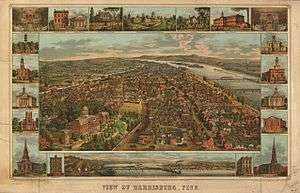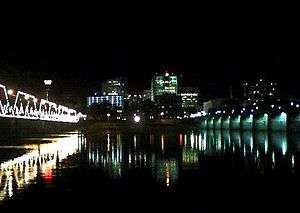History of Harrisburg, Pennsylvania
The history of Harrisburg, the state capital of the Commonwealth of Pennsylvania, United States, has played a key role in the development of the nation's industrial history, from its origins as a trading outpost to the present. Harrisburg has played a critical role in American history during the Westward Migration, the American Civil War, and the Industrial Revolution. During part of the 19th century, the building of the Pennsylvania Canal and later the Pennsylvania Railroad, allowed Harrisburg to become one of the most industrialized cities in the Northeastern United States.
Early settlement
The site along the Susquehanna River where Harrisburg is located is thought to have been inhabited by Native Americans as early as 3000 BC. Known to the Native Americans as "Peixtin," or "Paxtang," the area was an important resting place and crossroads for Native American traders, as the trails leading from the Delaware to the Ohio rivers, and from the Potomac to the Upper Susquehanna intersected there. The first European contact with Native Americans in Pennsylvania was made by the Englishman, Captain John Smith, who journeyed from Virginia up the Susquehanna River in 1608 and visited with the Susquehanna tribe. The Shawnees, a nomadic tribe, and members of the Algonquian nation came to the Susquehanna Valley from the southwest in the 1690s. The Swedes and the French used the Susquehanna River as a route during their explorations of the Middle Atlantic Region, but did not settle here.[1]
In 1719, John Harris, Sr., an English trader, settled here and 14 years later secured grants of 800 acres (3.2 km²) in this vicinity. That same year, 1733, Harris was granted a license to operate a ferry, and the place was long afterwards known as Harris's Ferry. In 1785, John Harris, Jr., made plans to lay out a town on his father's land, which he named Harrisburg. In the spring of 1785, the town was formally surveyed by William Maclay, who was a son-in-law of John Harris, Sr. In the following year, the city was temporarily renamed Louisburg in honor of Louis XVI, who had been helpful during the American Revolution. But John Harris refused to sell the land for the county seat under these terms, and it was agreed that the new name would be Harrisburg, in honor of his father.
A noted gathering of anti-Federalists, the Harrisburg Conference (or Convention), met here on September 3, 1788, to deliberate on the new Federal constitution. The meeting was well attended and adopted resolutions carrying 12 amendments to the constitution to be presented for action to the Pennsylvania legislature in form of a petition, however the petition was never formally presented.[2][3]
In 1791, Harrisburg became incorporated and was named the Pennsylvania state capital in October 1812. The cornerstone for the new capitol building was laid in 1819 by Governor William Findlay.
Nineteenth century

During the first part of the 19th century, Harrisburg was an important stopping place along the Underground Railroad, as escaped slaves would be transported across the Susquehanna River and were often fed and given supplies before heading north towards Canada.[4] The assembling here of the Harrisburg Convention in 1827 led to the passage of the high protective-tariff bill of 1828. In 1839, Harrison and Tyler were nominated for President of the United States at Harrisburg. By the 1830s Harrisburg was part of the Pennsylvania canal system and an important railroad center as well. Steel and iron became dominant industries. People from the rest of the nation were added to the original German settlers, along with. immigrants from throughout the Old World, especially Scots-Irish, Welsh, French, and Huguenots. Because farming was still the predominant industry, Harrisburg did not develop in the arts, music, and science as did Philadelphia. In 1860, Harrisburg was chartered as a city.
Steel and other industries continued to play a major role in the local economy throughout the latter part of the nineteenth century. The city was the center of a large amount of railroad traffic and supported large furnaces, rolling mills, and machine shops. The Pennsylvania Steel Company plant, which opened in nearby Steelton in 1866, was the first in the country; later operated by Bethlehem Steel.[5] Harrisburg Car Manufacturing Company began as a railroad car manufacturer in 1853; in 1935 the firm changed its name to Harrisburg Steel Company.
Civil War
During the American Civil War, Harrisburg was a significant training center for the Union Army, with tens of thousands of troops passing through Camp Curtin. It was also a major rail center and a vital link between the Atlantic coast and the Midwest, with several railroads running through the city and over the Susquehanna River. As a result of this importance, it was a target of General Robert E. Lee's Army of Northern Virginia during its two invasions. The first time during the 1862 Maryland Campaign, when Lee planned to capture the city after taking Harpers Ferry, West Virginia, but was prevented from doing so by the Battle of Antietam and his subsequent retreat back into Virginia.
The second attempt was made during the Gettysburg Campaign and was more substantial. Two full divisions of Richard S. Ewell's Second Corps approached Harrisburg in June 1863 from the southwest through Cumberland County, while a third division under Jubal Early planned to cross the Susquehanna River at Wrightsville, Pennsylvania, and attack Harrisburg from the rear. In response, Union Maj. Gen. Darius N. Couch, commanding the Department of the Susquehanna, dispatched troops to the present day borough of Camp Hill, located in the Cumberland Valley approximately 2 miles (3.2 km) west of Harrisburg. Laborers hired by Couch quickly erected earthworks and fortifications along the western portion of Bridgeport, adjacent to Camp Hill. The two largest of these became known as "Fort Couch" and "Fort Washington."
On June 29, two Confederate cavalry companies attacked Union militia positions around Oyster Point but were driven back with two wounded. This allowed officers from Ewell's staff to get a view of Harrisburg's fortifications from what is today the Drexel Hills development of New Cumberland. Based on their information, Ewell prepared for an attack but that same day Lee ordered Ewell to pull back. Lee had recently discovered that the Union Army of the Potomac was closer than he thought and desired to concentrate his forces near the South Mountain range to parry oncoming Union forces, a move that culminated in the Battle of Gettysburg. Ewell left two cavalry units behind at a place known as Sporting Hill, on the west side of Camp Hill. Brigadier General William F. Smith, commanding the 1st Division of the Department of the Susquehanna, sent two militia infantry regiments and a cavalry company to locate the Confederates. The two forces collided the next day, fighting a short skirmish at Sporting Hill before the Confederates withdrew. This is considered by many to be the northern-most battle of the Civil War.
Twentieth century
On February 2, 1897, the Capitol was gutted by a fire. Construction of a new capitol was commenced, with an expected budget of $5 to $10 million. However, by the time it was completed in 1906, the cost rose to $12.5 million, $4 million of which was for graft. (For example, $850 was spent for a $150 flagpole.) Five people, including the architect and chief contractor, received prison terms. The dedication of the Capitol was held on October 4 and attended by President Theodore Roosevelt.
In 1902, Vance McCormick was elected mayor of Harrisburg as part of the growing City Beautiful movement and immediately set about to improve the city. He expanded the city park system (which eventually included 1,100 acres), built steps along the Susquehanna River (which still exist today), paved seventy miles of roads, and improved the city water system. During this time, the population of the city increased from 51,000 to 73,000.
The Pennsylvania Farm Show, a major annual agriculture exposition, was first held in 1917 and has been held every January since then. The present location of the Show is the Pennsylvania Farm Show Complex & Expo Center, located at the corner of Maclay and Cameron streets.
On February 14, 1964, the Harrisburg Area Community College (or HACC) was founded as the first community college in Pennsylvania in the former Harrisburg Academy. In March 1965, the City of Harrisburg sold the college 157 acres (0.64 km2) in Wildwood Park for a permanent campus. Construction of the academic buildings was completed in 1967. HACC now has additional campuses in Lebanon, Lancaster, Gettysburg, and York, besides the main campus in Harrisburg (now called the Wildwood Campus).
In June 1972, Harrisburg was hit by another flood from the remnants of hurricane Agnes.
On March 28, 1979, the Three Mile Island nuclear plant, down the Susquehanna River from Harrisburg, suffered a partial meltdown. Although the meltdown was contained and a minimal amount of radiation was released, there were still worries that an evacuation would be necessary. Governor Richard Thornburgh did recommend an evacuation of pregnant women and preschool children who lived within a five-mile (8 km) radius of TMI. Although there were about 5,000 people covered by this recommendation, 140,000 people fled the area.

After Harrisburg suffered years of being in bad shape economically, Stephen R. Reed was elected mayor in 1981 and stalwartly served until his unexpected defeat in 2009 by Linda D. Thompson, making him the longest-serving mayor of Harrisburg. Once elected, Reed immediately started projects which would attract both businesses and tourists. Several museums and hotels such as the National Civil War Museum and the Hilton Harrisburg and Towers were built during his term, along with office buildings and residences. Several semi-professional sports franchises, including the Harrisburg Senators of the Eastern League, the defunct Harrisburg Heat indoor soccer club and the Harrisburg City Islanders of the USL Second Division, began operations in the city during his tenure as mayor.
21st century
In 2011 the city of Harrisburg filed a Chapter 9 bankruptcy petition. [6]
References
- city-data.com
- Rines, George Edwin, ed. (1920). . Encyclopedia Americana.
- Benjamin M. Nead (1920). . In Rines, George Edwin (ed.). Encyclopedia Americana.
- The Underground Railroad Archived 2006-09-20 at the Wayback Machine
- History of Steelton, PA Archived 2013-03-06 at the Wayback Machine
- https://money.cnn.com/2011/11/23/news/economy/harrisburg_bankruptcy/index.htm
| Wikimedia Commons has media related to History of Harrisburg, Pennsylvania. |